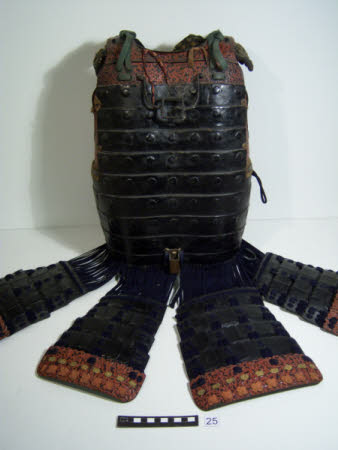Suit of armour
Category
Arms and armour
Date
1700 - 1750
Materials
Iron, leather, lacquer, silk, gold, silver
Place of origin
Japan
Order this imageCollection
Snowshill Manor and Garden, Gloucestershire
NT 1328775
Summary
A suit of armour for a boy, of ‘modern’ (tōsei gusoku) type, first half 18th century, consisting of a helmet (kabuto) with a fluted front, raised crown and neck guard (shikoro) with small turned-back front edges (fukikaeshi), a black-lacquered mask (menpō) of the Nara type (with fierce features), its nose restored, with attached full-laced (kebiki odoshi) three-plate throat guard (yodare-kake), the cuirass of the ‘Buddha cuirass’ (Hotoke dō) type (i.e. smooth and seamless like the chest of a statue of the Buddha), decorated with dragons among clouds in gold on black lacquer (dragons being a symbol of benevolent power), with two silver rings to the front to hang a baton and a small towel from (saihai no kan and tenugui no kan), with an upper breast plate (munaita) and upper side plates (wakiita) covered with stamped and gilded Chinese leather and gilded roped rims, with a Sagara family emblem (mon) in silver in the centre, also with Sagara mon on the pair of gold-lacquered and full-laced (kebiki odoshi) shoulder guards (sode), the chain mail (kusari) of the pair of sleeves (kote) set with pierced and gilded iron plates (ikada), also with a pair of thigh guards (haidate) and a pair of gold-lacquered ‘splint’ shin guards (shinozuneate, i.e. incorporating metal strips) surmounted by knee guards (tateage) of brigandine (cloth lined with metal plates in a hexagonal pattern, kikkō or ‘tortoise-shell-shaped’).
Full description
This suit of armour is unusual in having been made for a boy. The heraldic emblem (mon) seen on certain parts of this armour is that of the Sagara clan, who ruled the feudal domain of Hitoyoshi in present-day Kumamoto prefecture in Kyūshu. Presumably this suit of armour was made for a young member of the Sagara family, probably for some special occasion. The Sagara family traced their lineage back to the medieval princely Fujiwara clan and they had held the mountainous fief of Hitoyoshi since the late 12th century. In 1600, during the culmination of a period of civil war (known as the Sengoku period), Daimyō (or Lord) Sagara Nagatsune (1574–1636) switched his allegiance to the warlord Tokugawa Ieyasu (1543–1616), who would go on to unify Japan, allowing the Sagara family to continue to rule over their domain until the 1870s. During the Edo period (1600–1868) Japan was generally at peace, and armour tended to be worn on ceremonial occasions. During the 1870s, as the Japanese government was trying to modernise Japan along Western lines, the feudal system and the samurai warrior class were abolished, so that there were fewer occasions to wear or display traditional suits of armour. The social and economic upheaval of the period also caused many aristocratic and samurai families to fall on hard times, forcing them to sell heirlooms including arms and armour. At the same time there was a strong interest in the arts and crafts of Japan in the West (the phenomenon known as Japonisme), so many of the traditional Japanese arms and armour that were coming on the market ended up in Europe and America. With the end of feudalism in Japan, the artisans who had supplied arms and armour to the samurai class for generations were forced to find new uses for their skills. Some of them began to make fine and decorative art objects aimed at foreign markets. A example of that phenomenon in the collection at Snowshill is the incense burner in the shape of a caparisoned elephant with a pavilion on its back, signed by Hasegawa Harusada (1800–83), NT 1333651. Japanese arms and armour strongly appealed to Charles Wade (1883–1956), who was enthralled by design and craft traditions and had an appreciation of objects with a distinct presence. It is interesting that he acquired many of the suits of armour now at Snowshill in the late 1930s and early 1940s, when the influence of Japonisme had waned and such objects would have been relatively unfashionable in Britain. Wade purchased this particular suit of armour, together with three others, from Percy C. Ashby in Towcester, Northamptonshire, on 17 February 1940, for £10 10s. Poignantly, by the early 1940s Japan had turned itself into a Western-style imperialist power and was about to engage in a bitter war with the British Empire and the United States (1941–5). Charles Paget Wade notebook (1340945.3 /SNO.959.3) entry no. 372: 'Suit of Armour. Helmet of black lacquer. The front ‘ϯ’ fluted, with curious raised crown. Small wings & (sketch of helmet here) neck guard. Body composed of oblong lacquered plates of convex form connected by chain. Small shoulder guards. breast has a dragon in repoussé of brass. 3 claws. sleeves & leg guards of plate & chain. Apron all chain. Spear with long straight blade, mother o’pearl shaft. Short sword. fr.Towcester ‘ϯ’ Foot Soldier’s Armour – made to be folded into a small package. 17th Cent.'
Provenance
Purchased by Charles Paget Wade (1883–1956), together with three other Japanese suits of armour, from Percy C. Ashby, Towcester, Northamptonshire, 17 February 1940, for £10 10s; given by Wade to the National Trust, 1951.
